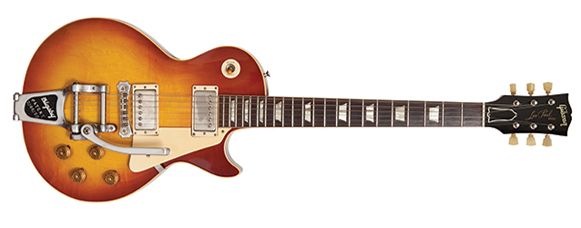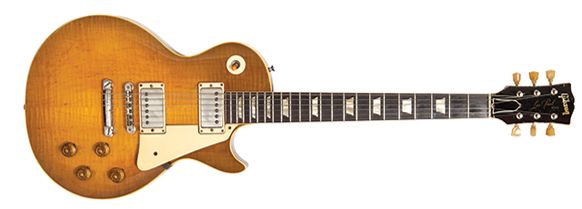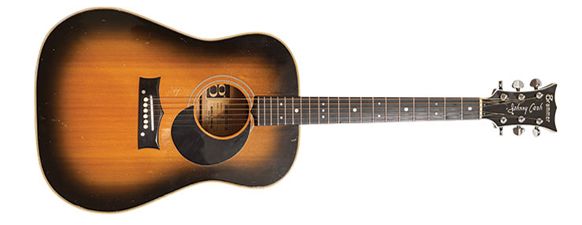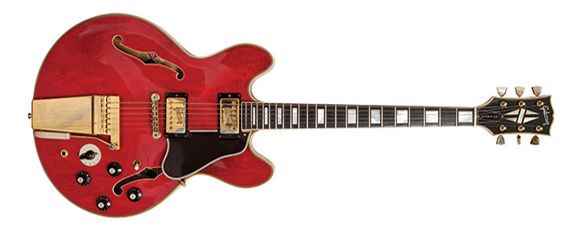The One Thing You Should Know About Guitar Collecting
UNLIKE SLASH, ZAKK WYLDE, Dave Navarro, John 5, and other more outwardly recognizable Los Angeles guitar heroes, Joe Bonamassa can walk through a bustling music store totally unnoticed.
A few years back, in a Reno guitar shop, Bonamassa was tempted by a pristine 1987 Marshall Silver Jubilee head (“I can’t have too many of those”). He asked for the price.
“The guy at the counter said, ‘It’s $4,000,’ ” Bonamassa recalls. “I asked him why the price was so high, and he said, ‘Well, Slash used Jubilees for the Guns N’ Roses tone, and now this kid Joe Bonamassa is using them, so it’s $4,000.’ ”
Of course, Bonamassa’s amp collection extends way beyond Marshalls (“I have Dumbles, and at least one of every tweed Fender model ever made, in mint condition”), and his collection of über-valuable vintage guitars continues to grow.
“I have every year of Les Paul from ’52 through ’61, including three PAF goldtops, six ’bursts, and one factory black Standard, which is actually more valuable than a ’burst,” says Bonamassa, who also has some cherry ES-335s. “And I’ve got five original [Fifties] blackguard Telecasters, as well as every year of Stratocaster from ’55 through ’61, including four blondes and the very first black Strat ever built, which was custom made for Howard Reed, Jr., of Gene Vincent and the Blue Caps.”
While Bonamassa’s astounding amassment of near-priceless guitar gear certainly qualifies as a collection, a better word for it might be “stable,” because, metaphorically speaking, Bonamassa rides these horses. “I play what I own,” he says. “There are no glass cases in my house, and I’m not a huge believer in hanging guitars by their necks. I wouldn’t want to be hung by the scruff my neck on permanent display, and I think a guitar feels the same way—especially if it’s glued together, like an eight-pound Les Paul.”
Bonamassa’s storage tips are simple. “If you’re in a cold climate, don’t keep guitars by the heater,” he says. “Generally, guitars like to be in a place that’s between 68 and 72 degrees with about 45 to 55 percent humidity, which on any given day is what a typical house provides.
"Guitars don’t like extremes, and they certainly don’t like to be wet. Moisture is the worst. It’s better for a neck to dry out and require new frets than it is for it to get wet, because wood tends to go back to its natural state [and warp] when it’s wet.”
According to Bonamassa, it doesn’t matter if you’re holding millions of dollars worth of guitars or just 800 bucks worth.
“The trick with guitar collecting,” he says, “is to ask yourself, ‘If these were worth nothing at the end of the day, would I still love them and play them?’ If the answer is yes, you’re doing all right.
"If your dream guitar is a beat-up 1965 Harmony Rocket that’s been through a fire and a flood and looks like somebody took it into the backyard and shot holes into it with an old pistol, then that’s your dream guitar.”
1959 Gibson Les Paul Standard Serial Number 9-0829
“This one’s called Magellan, because it’s been around the globe with me—at least where it’s safe to travel with such an expensive instrument. Airline rules state that if you want to carry such an expensive guitar, you must buy a seat for it. The good news is that they will serve both a Burst and its owner a gin and tonic.”

1960 Gibson Les Paul Standard Serial Number 0-0137
“I’m the third owner of this truly special Burst, which was ordered in June of 1959 and delivered in August of that year. Although the stamp indicates that it was made in 1960, it’s got all 1959 features. I sometimes call it Batman because of the weird winged bridge—a one-off. And I’m honored that Gibson Custom recently recreated the guitar in exacting detail as Collector’s Choice #3.”

1959 Gibson Les Paul Standard Serial Number 9-1951
“This guitar was originally known to the general public as the Skinner Burst [after the auction house that sold it in 2006], but I have renamed it Principal Skinner. Killer in every way. This is the most rock Les Paul I own. Big flame equals big tone.”

1969 Grammer Johnny Cash
“This guitar has an unusual look—a grey-burst finish—which was apparently designed to look good with Johnny Cash’s black attire. It’s a rare bird with an incredible tone. Everyone who plays this guitar is surprised by the sound and wants to take it home.”

1932 Martin 0-17
“This 0-17 came from my repair guy in L.A. Someone who had inherited it from her grandmother had left it in the shop and forgotten about it, so I offered to give it a second life. It’s a really sweet-sounding little guitar.”

1959 Gibson Les Paul Standard Serial Number 9-0829
“This one’s called Magellan, because it’s been around the globe with me—at least where it’s safe to travel with such an expensive instrument. Airline rules state that if you want to carry such an expensive guitar, you must buy a seat for it. The good news is that they will serve both a Burst and its owner a gin and tonic.”












Click here to share joe's interview on